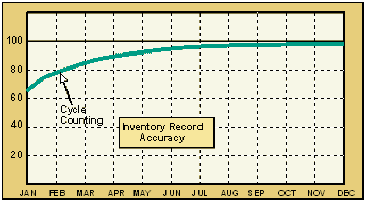Hazards In Cycle Counting
Cycle counting is not always a panacea. things can and do go wrong and produce a lot of cost
and effort with little result. among the hazards:
Insufficient Staffing--This results from under-estimating the number of counts required when
the program is initially planned.
Diversion of Effort--To the rest of the organization, cycle counting seems to accomplish
little of immediate importance. Cycle counters become a convenient source of staff for all sorts
of odd jobs. Over time the practice of borrowing cycle counters dilutes the effort and
reinforces the perception of non-accomplishment.
Ignoring Error Creation--Error prevention is always more productive than correction. Some
systems create errors so fast that it is impractical to cycle count enough for high
accuracy.
Insufficient Training--Cycle counters need training on counting properly and on resolving
discrepancies. Others in the organization need training to support the program.
Motivation--Cycle counting tends to be boring and specific means should be employed for
recognition and rewards.
|
What To Expect
|

Figure 4-- IRA with
Cycle Counting
|
Cycle counting, by itself, takes considerable time to show results. As accuracy rises to the
90% range, further results are even slower because each weekly sample contains fewer errors.
Figures 3 and 4 illustrate.
With insufficient staffing and counting, the IRA curve can rise much slower or even decline
as counters struggle against a tide of new errors. The key to improving effectiveness at high
accuracies is prevention through reducing
transaction volume and reducing transaction
errors.
There is, of course, more to implementing
and designing a cycle count program than we present here. Cycle Counting, itself, can be and
should be quite simple even if the statistical theory is not so simple.
 Most organizations need a comprehensive Inventory Accuracy program, not just cycle counting. Most organizations need a comprehensive Inventory Accuracy program, not just cycle counting.
|






